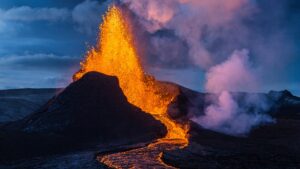 Scientists have long used clear warning signs like earthquakes and ground swelling to predict volcanic eruptions. But some volcanoes erupt without giving such clues, putting nearby people and air traffic at risk. These are called “stealth” volcanoes and now, new research from Alaska’s Veniaminof volcano may help explain why they stay so quiet before exploding.
Scientists have long used clear warning signs like earthquakes and ground swelling to predict volcanic eruptions. But some volcanoes erupt without giving such clues, putting nearby people and air traffic at risk. These are called “stealth” volcanoes and now, new research from Alaska’s Veniaminof volcano may help explain why they stay so quiet before exploding.
A team led by Dr Yuyu Li from the University of Illinois studied Veniaminof one of Alaska’s most active volcanoes to find out why many of its eruptions give little or no warning. Their findings, published in Frontiers in Earth Science, reveal that conditions deep inside the volcano play a key role.
“Even with advanced monitoring, some volcanoes erupt suddenly, catching us off guard,” said Dr Li. “Many such volcanoes are located near big cities or flight paths, like Popocatépetl in Mexico or Stromboli in Italy. Our work shows what’s happening underground that makes these eruptions so sneaky.”
Why Some Volcanoes Give No Warning
Veniaminof has erupted 13 times since 1993, but only two eruptions were spotted early enough to warn people. In 2021, its eruption wasn’t detected until three days after it began. To understand why, the researchers built a computer model using real monitoring data from the years leading up to its 2018 eruption.
The model tested different underground conditions — the size, shape, and depth of the magma chamber, how fast magma flowed in, and how hot the surrounding rock was. They found that eruptions stay hidden when three things happen together:
•The magma flow is slow,
•The chamber is small,
•The chamber is warm.
Under these conditions, the ground above does not swell or shake enough for scientists to notice. “A warm chamber stretches gently instead of cracking, hiding signs of danger,” explained Dr Li.
A Game of Size, Shape, and Temperature
The shape of the magma chamber also matters. A flat, wide chamber produces fewer earthquakes. A long, narrow chamber may not cause much ground deformation. But when the rock around the chamber is warm because magma sits there over long periods the risk of stealth eruptions rises. Warm rocks are soft and less likely to break in ways that alert scientists.
At Veniaminof, the model suggests a small, warm magma chamber and a slow magma flow — the perfect recipe for quiet, stealthy eruptions.
Better Tools, Better Warnings
So how can scientists improve their chances of catching these surprise eruptions? Dr Li suggests adding better equipment like tiltmeters, strainmeters, fiber optic sensors, and gas detectors. Satellite coverage and new technologies like infrasound (low-frequency sound detection) could also help.
Even artificial intelligence could play a role. “Machine learning is helping to pick up faint signals we might miss,” Dr Li said.
For now, experts will focus on watching volcanoes with the highest stealth risk those with small, warm magma chambers and slow-moving magma. Combining models like this with live data could improve early warnings, saving lives and protecting communities in the future.
